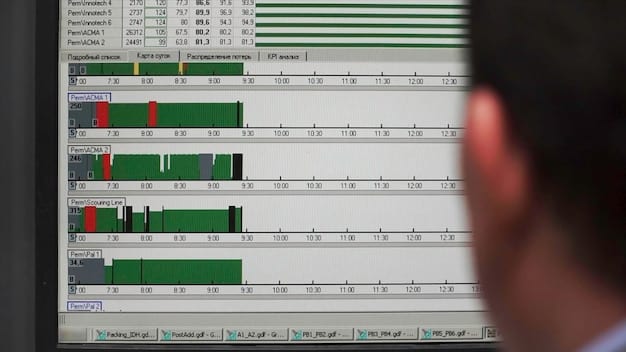Refinance Your Mortgage in 2025: The Ultimate Guide

Refinancing a mortgage in 2025 involves replacing an existing home loan with a new one, typically to secure lower interest rates, reduce monthly payments, or access home equity, requiring careful consideration of market conditions, personal financial goals, and associated costs for optimal benefit.
Navigating the complex world of personal finance can often feel like charting an unknown course, especially when it comes to significant decisions like homeownership. One strategy that consistently garners attention is mortgage refinancing. This comprehensive guide, Personal Finance: The Ultimate Guide to Refinancing Your Mortgage in 2025, aims to demystify the process, offering insights and practical advice for homeowners considering this crucial financial maneuver in the coming year. We’ll explore why refinancing might be a wise choice, what factors to weigh, and how to approach the process strategically.
Understanding Mortgage Refinancing in 2025
Mortgage refinancing, at its core, is the process of replacing an existing mortgage with a new one. This new loan pays off the old one, and you then make payments on the new loan. While the concept seems straightforward, the motivations and intricacies behind refinancing can be quite diverse, especially as economic conditions and interest rates fluctuate. In 2025, several factors could make refinancing an attractive option for homeowners seeking to optimize their financial position.
The primary reasons for refinancing typically revolve around achieving more favorable loan terms. This could mean securing a lower interest rate, which directly translates to reduced monthly payments over the life of the loan. Alternatively, homeowners might seek to shorten their loan term, aiming to pay off their mortgage faster, albeit often with higher monthly payments. Another common objective is to convert an adjustable-rate mortgage (ARM) into a fixed-rate mortgage, providing stability and predictability in payments, particularly valuable in periods of rising interest rates.
Key Benefits of Refinancing
Understanding the potential advantages is crucial before embarking on the refinancing journey. The benefits extend beyond just lower interest rates and can significantly impact your long-term financial health.
- Lower Interest Rates: This is often the primary driver. Even a small reduction in your interest rate can save you tens of thousands of dollars over the loan’s lifetime. In a dynamic market like 2025, tracking rate movements becomes paramount.
- Reduced Monthly Payments: A lower interest rate or an extended loan term can lead to more manageable monthly payments, freeing up cash flow for other financial goals or expenses.
- Shorter Loan Term: If you’re able to secure a significantly lower rate, you might be able to shorten your loan term (e.g., from 30 years to 15 years) without a drastic increase in monthly payments, leading to substantial interest savings and faster equity build-up.
Beyond these, refinancing can also be used to remove private mortgage insurance (PMI) once you’ve reached sufficient equity, or to consolidate other debts into your mortgage, potentially at a lower interest rate, though this should be approached with caution. The choice to refinance should always align with your broader financial strategy for 2025 and beyond.
When is the Right Time to Refinance? Analyzing 2025 Market Conditions
Determining the optimal time to refinance is a critical decision that hinges on a confluence of personal financial circumstances and broader economic indicators. For a homeowner considering refinancing in 2025, understanding the evolving market landscape is paramount. Interest rates are dynamic, influenced by federal reserve policies, inflation, and global economic stability. A slight dip in rates could translate into significant savings over the life of a loan, making it imperative to monitor these trends regularly. Beyond interest rates, the housing market itself plays a role; robust home value appreciation can increase your equity, opening up more refinancing options, such as cash-out refinances.
Forecasting economic shifts for 2025 involves analyzing expert predictions regarding inflation, GDP growth, and employment rates, all of which indirectly affect mortgage rates. Staying informed through reputable financial news sources and consulting with mortgage professionals can provide valuable insights into market trajectories. Furthermore, individual financial health is equally important. A strong credit score, a stable income, and a low debt-to-income ratio will significantly improve your chances of securing favorable refinancing terms, regardless of market conditions.
Factors Indicating a Good Time to Refinance
Several indicators can signal that 2025 might be an opportune year for you to refinance. These are not just about rates but also about your personal standing.
- Significant Drop in Interest Rates: If current rates are AT LEAST 0.75-1% lower than your existing mortgage rate, it’s generally a strong signal to consider refinancing.
- Improved Credit Score: A higher credit score since you took out your original mortgage can qualify you for better rates and terms.
- Increased Home Equity: Having substantial equity in your home (typically 20% or more) can eliminate the need for private mortgage insurance (PMI) or allow for a cash-out refinance.
The goal is to ensure that the savings from refinancing outweigh the closing costs and any potential fees. A detailed cost-benefit analysis is an indispensable step to validate the decision. Remember, what’s right for one homeowner might not be ideal for another, underlining the importance of personalized evaluation.
Types of Mortgage Refinancing: Choosing Your Path in 2025
In 2025, homeowners considering refinancing will find an array of options, each tailored to different financial objectives. Understanding these distinct types is crucial for making an informed decision that aligns with your personal finance goals. The most common form is the Rate-and-Term Refinance, which involves securing a new loan with a lower interest rate or a different loan term (e.g., shortening a 30-year mortgage to 15 years, or extending a 15-year to 30 years for lower monthly payments). This type is ideal for homeowners whose primary aim is to reduce their monthly outgoings or pay off their mortgage faster without tapping into their home equity.
Another popular option is the Cash-Out Refinance. This allows homeowners to borrow against their home equity, receiving a lump sum of cash at closing. The new mortgage is for a higher amount than the existing balance, with the difference being the cash taken out. This cash can be used for various purposes, such as home improvements, debt consolidation, or funding education. However, it’s important to approach cash-out refinancing cautiously, as it increases your debt burden and further secures that debt with your home as collateral. Interest rates for cash-out refinances might also differ from rate-and-term options.

Lastly, for homeowners with adjustable-rate mortgages (ARMs), an ARM-to-Fixed Refinance is a strategic move. This converts a loan with fluctuating interest rates into one with a stable, predictable monthly payment, offering peace of mind and protection against potential rate hikes. The suitability of each type depends entirely on individual financial situations, risk tolerance, and future plans for their property. It is wise to consider how changes in loan structure could impact your overall financial landscape in 2025.
Evaluating Specific Refinance Types
Each refinancing type presents unique advantages and disadvantages, making a thorough evaluation necessary.
- Rate-and-Term Refinance:
- Pros: Lower monthly payments, potential for significant interest savings over time, shorter loan term options.
- Cons: Incurs closing costs, might reset your loan term back to the original length if not careful, no cash out.
- Cash-Out Refinance:
- Pros: Access to large sums of cash, typically at a lower interest rate than personal loans or credit cards.
- Cons: Increases total debt, puts your home at greater risk, closing costs apply, can reduce equity.
- ARM-to-Fixed Refinance:
- Pros: Predictable monthly payments, protection against future interest rate increases.
- Cons: May result in a higher initial interest rate if current fixed rates are above your ARM’s initial rate.
Beyond these, government-backed refinancing programs like FHA Streamline and VA Streamline Refinance exist for eligible borrowers, often offering simplified processes and reduced documentation. Consulting with a mortgage lender or financial advisor can help clarify which option is best suited for your financial realities in 2025, taking into account any specific regional or national incentives that may apply.
The Refinancing Process in 2025: A Step-by-Step Guide
Embarking on a mortgage refinance journey in 2025 involves a structured process, from initial research to final closing. Understanding each step can help you navigate the complexities with confidence and efficiency. The first crucial step is to assess your current financial health and determine your objectives. Are you looking for lower monthly payments, a shorter loan term, or access to home equity? Your goals will dictate the type of refinance best suited for you. This self-assessment also includes reviewing your credit score, debt-to-income ratio, and current home equity, as these factors significantly influence your eligibility and the rates you’ll be offered.
Once your objectives are clear, the next step involves gathering necessary documentation and comparing offers from multiple lenders. This comparison is vital, as rates, fees, and terms can vary significantly between financial institutions. Don’t just look at the interest rate; consider the Annual Percentage Rate (APR), which includes fees, and all closing costs. Online calculators and direct consultations with lenders can provide personalized quotes. After selecting a lender, you’ll formally apply, which typically involves submitting a detailed financial application along with supporting documents like pay stubs, tax returns, bank statements, and current mortgage statements. The lender will then process your application, which includes performing a credit check, ordering an appraisal of your home, and verifying your employment and assets.
Key Stages of the Refinancing Process
Navigating the refinancing process requires attention to detail at each stage to ensure a smooth transition to your new mortgage.
- Application Submission: Provide all requested financial documents. Timeliness and accuracy are key.
- Underwriting: The lender reviews your financial information, credit history, and home appraisal to assess risk and determine approval.
- Appraisal and Title Search: An appraisal determines your home’s current market value, which is crucial for loan approval. A title search ensures there are no outstanding liens on your property.
Finally, upon approval, you will proceed to loan closing. This is where you sign the final loan documents, and the new mortgage replaces your old one. Be sure to review every document carefully, particularly the Closing Disclosure, which details all costs and terms. Any questions or discrepancies should be addressed before signing. The entire process can take anywhere from 30 to 60 days, depending on the complexity of your situation and the lender’s efficiency. Being organized and proactive throughout will help streamline your refinancing experience in 2025.
Costs Associated with Refinancing: What to Expect in 2025
While the allure of lower interest rates or accessible home equity makes refinancing an attractive option, it’s crucial for homeowners in 2025 to understand that this financial maneuver comes with associated costs. These costs, often referred to as “closing costs,” can significantly impact the overall benefit of refinancing if not properly accounted for. Typically, closing costs range from 2% to 5% of the loan amount, but this can vary based on your lender, loan type, and geographical location. It’s not a one-size-fits-all scenario, and a detailed breakdown is essential for accurate financial planning.
These expenses generally fall into several categories. Lender fees include charges for loan origination, which covers the administrative costs of processing your loan, and potentially discount points, which are prepaid interest that can lower your overall interest rate. Third-party fees encompass a broader range of services, such as appraisal fees to determine your home’s current market value, title search and insurance fees to ensure clear ownership, and attorney fees if required in your state. Other costs might include recording fees by government entities and credit report fees. Understanding each component of these costs is vital for calculating the true expense of refinancing.
Breaking Down Refinancing Costs
To provide a clearer picture, here’s a common breakdown of the major costs you might encounter when refinancing in 2025:
- Lender Fees:
- Origination Fee: Typically 0.5% to 1% of the loan amount, covering the lender’s processing costs.
- Discount Points: Each point costs 1% of the loan amount and reduces your interest rate. This is optional but can lead to long-term savings.
- Underwriting Fee: For the assessment of the loan application.
- Third-Party Fees:
- Appraisal Fee: Ranges from $300 to $600, for an independent valuation of your home.
- Title Search & Insurance: Ensures property ownership is clear and protects the lender and borrower. Can be substantial, varying widely by state.
- Survey Fee: If required, to confirm property lines.
- Attorney Fees: Required in some states for handling the closing.
- Government Fees:
- Recording Fees: Charged by your local government to record the new mortgage.
- Transfer Taxes: In some areas, a tax on transferring the property title, though usually lower for refinances.
These costs can often be rolled into your new loan amount, reducing your upfront out-of-pocket expense. However, doing so means you’ll pay interest on these costs over the life of the loan, increasing your total debt. Alternatively, you can pay them upfront. A proper cost-benefit analysis is essential to determine if the long-term savings from a lower interest rate outweigh these upfront expenditures. Always request a detailed Loan Estimate from your lender to review all fees before committing to a refinance in 2025.

Common Pitfalls and How to Avoid Them in 2025
While mortgage refinancing can be a powerful financial tool, it’s not without its potential pitfalls. Homeowners looking to refinance in 2025 must be aware of these common mistakes to ensure a smooth and beneficial outcome. One significant misstep is focusing solely on the interest rate without considering the total cost of the loan, including all closing fees. A slightly lower interest rate might not be worth it if the closing costs are excessively high, leading to a break-even point that extends far into the future, potentially beyond the time you plan to stay in the home. Always request a detailed Loan Estimate and compare the Annual Percentage Rate (APR), which provides a more accurate representation of the total cost.
Another frequent error is extending the loan term unnecessarily, especially when seeking lower monthly payments. While a longer term reduces your immediate payment, it significantly increases the total interest paid over the life of the loan. For example, refinancing a 15-year-old 30-year mortgage back into a new 30-year mortgage means you’ll be paying for 45 years. If your goal is to save money long-term, try to maintain or shorten your loan term. Overlooking the impact on your credit score during the application process can also be detrimental. Multiple hard inquiries from lenders in a short period can temporarily lower your credit score, potentially affecting the rates you’re offered. It’s wise to do your rate shopping within a concentrated timeframe, typically 14-45 days, to minimize the impact on your credit.
Avoiding Refinancing Mistakes
Careful planning and attention to detail are paramount to circumvent common refinancing errors. Consider these strategies to ensure a successful refinance in 2025:
- Do the Math Diligently:
- Calculate your “break-even point”—the time it takes for the savings from your new interest rate to offset your closing costs. If your break-even point is longer than you plan to stay in the home, refinancing may not be beneficial.
- Use a refinancing calculator to model different scenarios—changing interest rates, loan terms, and closing costs.
- Don’t Be Chased by “Low Rates”:
- While a low rate is attractive, ensure it aligns with your long-term financial goals. Sometimes, a slightly higher rate with lower closing costs can be better if you plan to move soon.
- Beware of “no-closing-cost” refinances, as these costs are typically baked into a higher interest rate or larger loan amount.
- Understand Your Equity and LTV:
- Know your Loan-to-Value (LTV) ratio. If your LTV is too high (i.e., you have too little equity), you might be subject to Private Mortgage Insurance (PMI) or higher interest rates.
- Consider a cash-out refinance only if absolutely necessary and for financially sound reasons, as it reduces your home equity.
Finally, always read the fine print of your loan documents. Understand all fees, prepayment penalties, and the exact terms of your new loan. If anything is unclear, ask for clarification. A well-informed homeowner is less likely to fall victim to refinancing pitfalls and more likely to achieve their financial objectives in 2025.
Expert Tips for a Successful Refinance in 2025
Navigating the mortgage refinancing landscape in 2025 effectively requires more than just understanding the basics; it demands strategic planning and astute decision-making. Drawing upon expert advice can significantly enhance your chances of a successful outcome tailored to your financial goals. One paramount tip is to bolster your credit score well in advance of applying. Lenders use your credit score as a key indicator of your financial responsibility, and a higher score translates directly into lower interest rates and more favorable terms. Simple actions like paying bills on time, reducing outstanding debt, and correcting any errors on your credit report can make a substantial difference.
Another critical piece of advice is to shop around thoroughly. While it might be tempting to stick with your current lender, exploring options from multiple financial institutions can uncover significant variations in interest rates, fees, and customer service. Obtain at least three to five loan estimates to compare side-by-side, paying close attention to the Annual Percentage Rate (APR) and all associated closing costs. Don’t hesitate to negotiate; lenders are often willing to waive certain fees or offer slightly better rates to win your business, especially if your financial profile is strong. A proactive approach to comparing offers ensures you secure the most competitive terms available in 2025.
Strategic Considerations for Your 2025 Refinance
Beyond the fundamental steps, several strategic considerations can optimize your refinancing benefits.
- Prepare Your Documents Early:
- Gather all necessary financial paperwork, including pay stubs, tax returns, bank statements, and current mortgage statements, before you even apply. This demonstrates readiness and can speed up the approval process.
- Timely submission of accurate documents reduces delays and potential complications.
- Understand Your Break-Even Point:
- Determine how long it will take for the savings from your lower interest rate to recoup your closing costs. If you plan to move before reaching this point, refinancing might not be financially advantageous.
- This calculation helps you assess the true value proposition of the refinance.
- Consider a Shorter Loan Term:
- If current interest rates are significantly lower, evaluate whether you can afford to switch to a shorter loan term (e.g., from 30 years to 15 years) without a drastic increase in your monthly payments. This can save you a substantial amount in interest over the life of the loan.
- A shorter term builds equity faster and helps you become debt-free sooner.
Finally, engage with a trusted financial advisor or mortgage professional. Their expertise can provide personalized insights, help you navigate complex scenarios, and ensure that your refinancing decisions align with your broader financial objectives. Staying informed, being prepared, and diligently comparing options are the cornerstones of a successful mortgage refinance in 2025.
| Key Point | Brief Description |
|---|---|
| 📊 Weighing the Costs | Refinancing involves closing costs (2-5% of loan) which include lender, third-party, and government fees. Evaluate if savings outweigh these upfront expenses. |
| 📈 Market Timing | Monitor 2025 interest rates and economic forecasts. A drop of 0.75-1% from your current rate is often a good trigger for consideration. |
| 🏡 Types of Refinance | Choose between Rate-and-Term (lower rates/new term), Cash-Out (equity access), or ARM-to-Fixed (payment stability) based on your financial goals. |
| ✅ Smart Strategies | Boost credit, compare multiple lenders, gather documents early, and understand your break-even point to optimize refinancing benefits. |
Frequently Asked Questions About Mortgage Refinancing in 2025
▼
Generally, a credit score of 740 or higher is considered excellent and will qualify you for the most competitive interest rates when refinancing in 2025. However, options may exist for scores in the high 600s, though at potentially higher rates. Improving your score beforehand can yield significant savings.
▼
A cash-out refinance replaces your current mortgage with a larger one, giving you the difference in cash. It’s often a good idea for funding major home improvements that add value, consolidating high-interest debt, or covering significant expenses, provided you have substantial home equity and a clear repayment plan.
▼
Yes, you can refinance an FHA loan, often through an FHA Streamline Refinance. This program typically requires less paperwork, no appraisal, and no credit check, making it simpler if you meet the eligibility criteria, such as having a current FHA mortgage and a history of on-time payments.
▼
“No-closing-cost” refinances mean you don’t pay upfront fees. However, these costs aren’t truly free; they are usually covered by a slightly higher interest rate on your loan or added to the loan principal. While convenient, assess if the long-term cost increase outweighs the immediate savings.
▼
The refinancing process typically takes between 30 to 60 days from application to closing. However, this timeframe can vary based on individual circumstances, lender efficiency, the complexity of your loan, and current market demand. Being organized with your documents can help expedite the process.
Conclusion
The decision to refinance your mortgage in 2025 is a significant financial undertaking that demands careful consideration, detailed research, and a clear understanding of your personal financial landscape. As economic conditions and interest rates continue to evolve, staying informed on market trends is paramount. Whether your goal is to lower monthly payments, shorten your loan term, or access home equity, a strategic approach coupled with a thorough evaluation of all associated costs and potential pitfalls will pave the way for a successful outcome. By leveraging expert tips, preparing diligently, and comparing offers from multiple lenders, homeowners can confidently navigate the refinancing process, ultimately strengthening their personal financial position for the years to come.





